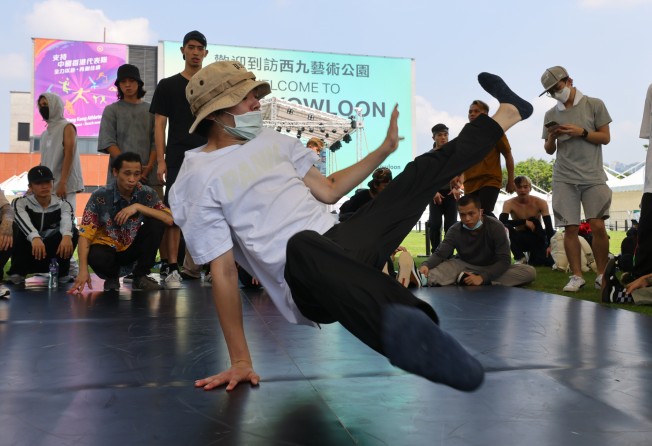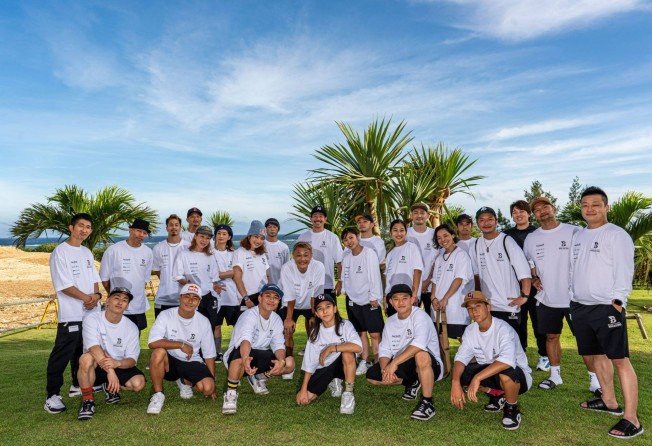
Paris Olympics: Japan’s breakers show Hong Kong Bboys and Bgirls a road map to 2024
- Pioneers in Japanese breakdancing such as Katsuyuki Ishikawa – Bboy Katsu – are inspiring counterparts in Hong Kong, says Jessica Siu, or Bgirl Mirage
- Katsu says the public ‘have to learn what breaking is’ as it builds towards its Olympic debut, when medals matter but respect means more

As Japan’s top breakdancers continue to plot their route to the Paris 2024 Olympic Games, where breaking is set to debut, the man overseeing it all is “speechless” at how far the craft has come.
“When I think back to when I started, it’s crazy. This was the dream back then,” said Katsuyuki Ishikawa, who is approaching his 25th year in breaking and leads the group, which is connected to the Japan DanceSport Federation.
Better known as Bboy Katsu, Ishikawa started as every fledgling Japanese dancer did: performing gratis on the streets in front of his city’s railway station.
Little did the Kawasaki native know that his home would eventually be referred to as “the mecca of Japanese breaking”.

Many of his fellow struggling breakers were “kind of gangsters, like bad”, while his old school friends would mercilessly try to “smash me” when they saw him rehearsing the “running man” and experimenting with other US-inspired moves.
“The ones older than me, their generation were even more crazy,” Ishikawa said, laughing.
“Everyone was just super-gangster. I practised outside the station because I was really poor and had no money to rent a studio every night. There was a lot of drama and complaints, because it was very noisy. Most people thought that being Bboys and Bgirls meant being street gangsters.”
After carving a bit of a presence – and distancing himself from the notorious town ruffians – Katsu would go to the city hall and explain to government officials what breaking was, why his crew were resorting to street performances, and how intertwining with urban culture could reap benefits.
“They didn’t listen back then,” he said. “But I never gave up. We started showcases at neighbouring city festivals and always reminded the public what breaking was. We’ve been doing that for 20 years now.

“Now, the mayor cooperates and wants Kawasaki to be a top breaking city in the world. We struggled at the start but it’s worth it after seeing what we’ve done.”
To say Ishikawa did it single-handed would be doing his peers a disservice, but his influence cannot be overstated. Of the country’s 47 prefectures, he has helped to launch breaking federations in 38, while organising nationwide competitions across all ages and levels, professional leagues, showcases with other “urban sports”, lucrative partnerships and more.
“I always feel like I need to do more – never satisfied or anything like that,” he said, reiterating that breaking should not be pigeonholed as either a sport or an art.
“Breaking is breaking. To be honest, if I get to do anything through breaking, I will do it. It’s my work, education, hobby. It means everything.”
‘Look at what Japan is doing’
Hong Kong breaker Jessica Siu Yue-pui, or Bgirl Mirage, has been training abroad to keep atop the ever-changing international landscape. She frequents South Korea and Japan – ranked world No 2 and 3, respectively, behind the United States – while maintaining, when back home, her UTLR852 crew, her new studio and her duties working for the Hong Kong DanceSport Association (HKDSA).
It would be unfair to compare Japan’s and Hong Kong’s breaking scenes given the former’s sheer scale and history, but Siu hopes aspiring local dancers will learn from their East Asian counterparts. The competitive aspect is but one part.
“As an outsider looking into Japan, I see every generation is united,” said Siu, who led Hong Kong at the world championships in January.
“You see kids talking to 20 or 40-year-olds, asking for advice, and the parents and older generations looking after and encouraging the younger kids. It really feels like there’s an integration of breaking with … life.
“Katsu organises so many competitions – high-school, primary-school, open categories – and everyone is like one big family [yet] with their own style and originality. You would never see that in Hong Kong. It’s so separated.
“In Japan, there’s no judgment if you ask questions. You don’t get asked, ‘Why do you not know this?’ In Hong Kong, there is real scrutiny, like, ‘I’m older, therefore you have to respect me.’ They might not explain the basics, and it feels like everything goes back to the drawing board because you have to learn everything from scratch yourself.
“If you ask any [breaker] which country they think is the most organised or prepared for the 2024 Olympics, everybody will say Japan. Katsu makes things look easy – press conferences, events, social media – but he sets his standards very high.
“Whereas we might only have so many high-level competitions a year, he has more than 10 every two to three weeks, in every category.
“It’s much more than just working towards a big day or event. If it’s for sports, Katsu looks at how physiotherapy, stretching and mobility integrate. Pre-Olympics, there was definitely more focus on culture, art – purely breaking – but he’s able to explain that the shift to being a breaking athlete is very different. But it’s a very organised road map.
“I end up talking to a lot of people, through travel as the HKDSA’s head of external affairs, and if they ask what they should do next, I say, ‘Look at what Japan is doing.’”
Japan earned three breaking medals at the Youth Olympics’ first “dancesport” class in 2018, and their B-girls continued to dominate at the World Breaking Championships in France at the start of this year.
But with the Olympics only two years away, there is no time to stop and celebrate.
After confirmation of breaking’s inclusion in Paris 2024 and Los Angeles 2028, Ishikawa described a “non-stop” barrage of sponsors, studios, fitness trainers and sports industry representatives interested in collaboration.
“We’re very lucky,” he said, adding that the Japanese government and Olympic Committee were also on board. “It’s been very difficult to pick, because it’s like a competition [for them]. I can’t believe this has happened.”
Shift to competitive breaking
Breaking’s presence in the Olympics was initially divisive, but some were won over after the Tokyo 2020 Games’ welcoming of fellow urban sports such as skateboarding, surfing and sport climbing. Esports, too, continues to knock on the doors of major international sporting events.
“There’s also in-line skating, [3x3] basketball, beatboxing, freestyle football … many new sports,” Ishikawa said. “Together, we’re all from the streets.
“But we don’t teach the Bboys and Bgirls. We know they really hate it when somebody says ‘you should do this’. We’ve been learning what breaking in sports is, because it’s new to us and we have to adjust. We have to work together.”
Not unlike the Japanese public two decades earlier, it took breakers time to warm to the idea of breaking in a competitive sports domain. Events are physically demanding, but judging is subjective.
Ishikawa and his staff have formed Japan’s national breaking team set-up, with Olympic selection criteria still being debated. The Covid-19 pandemic has not helped, with few competitions taking place.
“Yeah, we’re struggling with that part,” he said, although he added that the forced pivot to online meetings had improved communication between crews and organisers.
“We started with the Japan Championships. At first, it was the worst – some breakers were not interested. But we invited media and tried to explain what breaking was, and from the second year, more competed. Then in the third and fourth, a lot more.”
Medals will be important, but the ultimate aim transcends silverware or podiums.

“We’ll definitely try to get medals, but our goal is to show that breaking should be a lifestyle sport,” Ishikawa said. “How do we do that? I’m trying to make a breaking federation in every prefecture, so I can submit breaking as a sport for the Japan Games. Getting gold medals is just part of it.
“The first thing is [the public] have to learn what breaking is. We need to explain it to the people, and we have to understand, study, learn, and not become big-headed. There are a lot of Bboys and Bgirls who are super-big-headed. Maybe they are proud of themselves, but there needs to be a balance. We have to understand what people think, and they have to understand how we think.
“When we go to the park, whether it’s Japan or Hong Kong, we see lots of people playing basketball. But I don’t see Bboys and Bgirls getting the rhythm to rap and hip-hop. I want to see that. Even when I’m 70, I want to be listening and dancing to rap music.
“I want people to learn from breaking, because it gave me everything.”